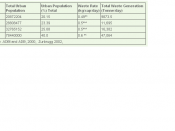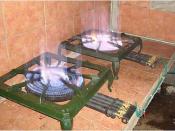Introduction:
Recent (2005-2007) estimates of Bangladesh's population range from 142 to 159 million, making it the 7th most populous nation in the world. With a land area of 144,000 square kilometers (55,600 sq mi (144,000 kmò), ranked 94th), the population density is remarkable and only Dhaka City itself comprises of approximately 12.2 million people. Indeed Bangladesh has the highest population density in the world, excluding a handful of city-states. In an average at least a thousand people live in every square kilometer of Bangladesh.
Bangladesh's population growth was among the highest in the world in the 1960s and 1970s, when the count grew from 50 to 90 million, but with the promotion of birth control in the 1980s, the growth rate slowed. This means that, with an ever growing population with unmet needs of sanitation, proper hygiene, housing, food security, in short the daily basic needs, the city itself has turned into an urban slum.
The waste generated from this population is an enormous amount of 3500 metric tons/day. This waste is hardly disposed of properly, and mismanagement has been occurring in this regard.
The majority of this solid waste ends up in poorly designed, if designed at all, landfills which are located right in the midst of residential areas. This is resulting in contamination of ground water and surface water, effecting the overall fertility of the soil, polluting the area, as well as, reducing the desirability of living in that area because of malodors, pest infestation, litter, proliferation of passive vectors which spread diseases, etc.
Thus, an integrated solid waste management has become a basic need for Dhaka City, if not for the whole of Bangladesh for its sheer survival. One of the main objectives of ISWM is to minimize this waste generation, however, waste itself cannot be...



Cool
I love it, its cool
0 out of 0 people found this comment useful.